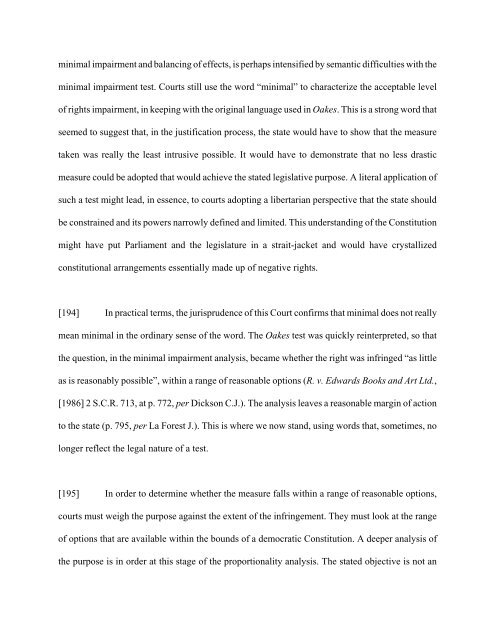SUPREME COURT OF CANADA CITATION: Alberta v. Hutterian ...
SUPREME COURT OF CANADA CITATION: Alberta v. Hutterian ...
SUPREME COURT OF CANADA CITATION: Alberta v. Hutterian ...
Create successful ePaper yourself
Turn your PDF publications into a flip-book with our unique Google optimized e-Paper software.
minimal impairment and balancing of effects, is perhaps intensified by semantic difficulties with theminimal impairment test. Courts still use the word “minimal” to characterize the acceptable levelof rights impairment, in keeping with the original language used in Oakes. This is a strong word thatseemed to suggest that, in the justification process, the state would have to show that the measuretaken was really the least intrusive possible. It would have to demonstrate that no less drasticmeasure could be adopted that would achieve the stated legislative purpose. A literal application ofsuch a test might lead, in essence, to courts adopting a libertarian perspective that the state shouldbe constrained and its powers narrowly defined and limited. This understanding of the Constitutionmight have put Parliament and the legislature in a strait-jacket and would have crystallizedconstitutional arrangements essentially made up of negative rights.[194] In practical terms, the jurisprudence of this Court confirms that minimal does not reallymean minimal in the ordinary sense of the word. The Oakes test was quickly reinterpreted, so thatthe question, in the minimal impairment analysis, became whether the right was infringed “as littleas is reasonably possible”, within a range of reasonable options (R. v. Edwards Books and Art Ltd.,[1986] 2 S.C.R. 713, at p. 772, per Dickson C.J.). The analysis leaves a reasonable margin of actionto the state (p. 795, per La Forest J.). This is where we now stand, using words that, sometimes, nolonger reflect the legal nature of a test.[195] In order to determine whether the measure falls within a range of reasonable options,courts must weigh the purpose against the extent of the infringement. They must look at the rangeof options that are available within the bounds of a democratic Constitution. A deeper analysis ofthe purpose is in order at this stage of the proportionality analysis. The stated objective is not an
















